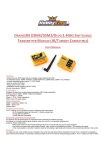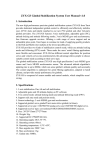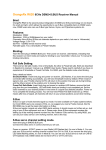Download ORX 2.4GHz Transmitter Module User`s Manual Thanks for your
Transcript
ORX 2.4GHz Transmitter Module User’s Manual Thanks for your purchase ORX 2.4GHz Transmitter Module; this design updates your transmitter to DSM2/DMSX 2.4GHz technology. There are three types; one for JR style transmitters, one for Futaba style transmitters, and a third which is configured for the DlY’er. Check your transmitter and pick the right module type for your use. ORX 2.4GHz Transmitter Modules work with all DSM2/DSMX aircraft receivers. Important Module Usage Information * Be sure the transmitter is in PPM mode. * Never power on the ORX 2.4GHz Transmitter Module without antenna. * Power the transmitter on first and wait for the beeps, then power on your receiver. * Before operating, make sure the receiver is properly bound to the transmitter module. * Before flying, always confirm that the module’s working mode is correct for your receiver. * Before flying, always perform a range check first. ORX 2.4GHz Transmitter Module Working Modes The ORX 2.4GHz Transmitter Module has four working modes. Turn the transmitter on and the green LED on the module will indicate the current working mode (see the table below). LED OFF flashes flashes flashes Working Mode DSM2 1024/22ms DSM2 2048/11ms DSMX 22ms DSMX 11ms Before binding the ORX 2.4GHz Transmitter Module, check your receiver specifications and select the proper ORX 2.4GHz Transmitter Module working mode. The working mode is indicated by the LED on the back of the ORX 2.4GHz Transmitter Module. The ORX 2.4GHz Transmitter Module only operates in a single working mode. It’s a little different from JR/Spektrum transmitters. That means that the ORX 2.4GHz Transmitter module mode must be changed manually when switching between DSMX and DSM2 receivers. If you have both DSM2 and DSMX receivers then you will need to remember the correct ORX 2.4GHz Transmitter module mode for each receiver and manually switch it before turning on the receiver. In every case, before you turn on your receiver, you need confirm the ORX 2.4GHz Transmitter Module’s working mode is correct for that receiver. Pay close attention to the receiver’s LEDs to ensure that it is working properly. Please remember that operating the ORX 2.4GHz Transmitter module in an incorrect working mode may result in an inability to drive your servos or it may drive them incorrectly, this is very dangerous. If the transmitter and receiver are not functioning together properly it may result in a crash or injury. How to Change the ORX 2.4GHz Transmitter Module Mode If the ORX 2.4GHz Transmitter Module mode is not correct for your receiver, you can change it. 1. Power on the transmitter and wait for the module to initialize (beeps) 2. Push the BIND button three times quickly 3. The LED on the ORX 2.4GHz Transmitter module will indicate the new mode 4. Repeat step 2 until the ORX 2.4GHz Transmitter module is in the desired mode. How to Bind a receiver to the ORX 2.4GHz Transmitter Module 1. Insert the Bind Plug in your receiver’s BIND port, power it on, and wait until the receiver LED is flashing. 2. Press and hold the BIND button on the back of the ORX 2.4GHz Transmitter Module while turning on your transmitter (your transmitter must always be set at PPM mode before). 3. Wait until the ORX 2.4GHz Transmitter Module beeps and the module LED slowly flashes twice (which means it’s at binding process) and release the BIND button. 3. Within a few seconds the LED(s) on the receiver should go solid, indicating the system has been connected. 4. Power off the receiver, remove the Bind Plug, and power it back on and verify proper receiver operation. Range Check With the model resting on the ground, stand 30 paces away (approx. 90 feet/28 meters). Press and hold the BIND button, you should have total control your model with the button depressed. Change ORX 2.4GHz Transmitter module ID Every ORX 2.4GHz Transmitter module has one GUID (Globally Unique Identifier), no another ORX 2.4GHz Transmitter will share it. The ORX 2.4GHz Transmitter module still has a Change ID button as a safeguard. This is provided for the near impossible case where another transmitter (not ORX) can control your model without binding. This near impossible case could happen as there are other DSM2/DSMX system manufacturers and they could use the same GUID. 1. Power on your transmitter 2. Press and hold the Change ID button 3. After a few seconds you will hear a beep, release the button. The ORX 2.4GHz Transmitter module’s ID has now changed. If you decide to change the ID, you will need to rebind all your receivers to this ORX 2.4GHz Transmitter Module. Channel Assignment Your transmitter’s channel assignments may not be the same as the JR/Spektrum receiver channel assignments. This means the channel assignments on your DSM2/DSMX receiver’s case may not match the typical controls on your transmitter (e.g., the JR receiver throttle connection may actually correspond to Futaba transmitter aileron output). You may need to connect your servos into receiver ports with different labels depending on the brand of transmitter you are using. Alternatively, you may be able to remap the transmitter’s controls to the corresponding DSM2/DSMX receiver channels if your transmitter supports such a feature. A third alternative is to download remapping firmware (after it’s launched) to update your ORX 2.4GHz Transmitter module. Fail Safe Fail Safe features are setup in your receiver. Please read your receivers manual carefully to setup this feature. It is very important that you pay attention to the channel assignments. As mentioned above, on the JR/Spektrum receivers the throttle is on the receiver’s CH1 (labeled as ‘THRO”) while the throttle output from your transmitter may actually be on a different channel. You need to be certain that you have all of the controls hooked up to the proper receiver connector and that all your controls are functioning properly before setting up Fail Safe.










